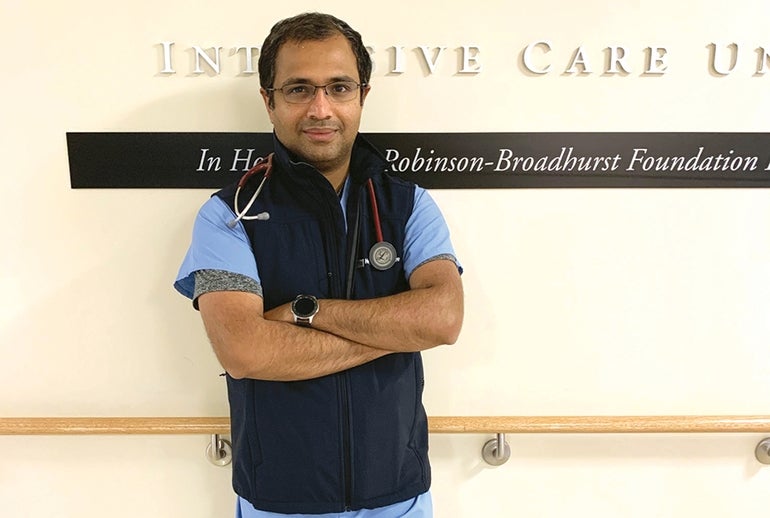Dr. Vinod Mohan, who leads infectious disease operations at Heywood Hospital, has spent just about every day since last December working to figure out the coronavirus, and help the hospital respond to it and plan for the rest of the pandemic.
Get Instant Access to This Article
Subscribe to Worcester Business Journal and get immediate access to all of our subscriber-only content and much more.
- Critical Central Massachusetts business news updated daily.
- Immediate access to all subscriber-only content on our website.
- Bi-weekly print or digital editions of our award-winning publication.
- Special bonus issues like the WBJ Book of Lists.
- Exclusive ticket prize draws for our in-person events.
Click here to purchase a paywall bypass link for this article.
Dr. Vinod Mohan still remembers hearing about a new contagious virus in China late last year, something called SARS-CoV-2, or better known as coronavirus. It could be like SARS-CoV-1 – the SARS outbreak from 2003 – Mohan figured, but no one could be sure. Mohan, a native of India who leads infectious disease operations at Heywood Hospital, has spent just about every day since last December working to figure out the coronavirus, and help the hospital respond to it and plan for the rest of the pandemic.
What were your first thoughts upon hearing about this new virus?
In December, once we started having some meetings in our circles at the hospital; we were hopeful because we didn’t know how the transmission of the virus worked. It was a brand new virus for human beings. We didn’t expect this to explode in the U.S.
Once it started spreading outside of Wuhan and Hubei province, and the U.S. Centers for Disease Control & Prevention started raising the threat level, obviously it ended up where we started having a COVID task force and started planning for it coming here.
Initially, I believe we thought it was all contained. That all changed once there was community transmission in the United States. Until then, we were screening people by asking whether they had been to China. And if not, we saw the risk as being very low.
Even before the Biogen conference outbreak in Boston in February, we knew at some point, “OK, it’s coming.”
Were there previous outbreaks that you looked to for guidance?
We had some experience from planning for Ebola. There were a lot of discussions then about what would happen if a virus were to come to the U.S. In this case, unlike Ebola, we didn’t know the nature of the virus.
If you compare it to SARS in 2003, the difference is in the way it spread. The earlier one didn’t have the characteristics that helped it spread fast. It’s much more contagious now. The fact you can be asymptomatic is also a challenge. If I get really sick, I’m not walking around and getting other people sick. With COVID-19, there’s that longer period of time before you get symptoms, or you may not get symptoms. That increases the chances that you’ll infect other people.
How did Heywood fare in the early days, in terms of having enough patient beds and personal protective equipment?
It was very tight. The good thing is that people came together. The intensive care unit was an issue, and we had to get portable air filters for negative-pressure rooms to keep contaminated air out. The venting and everything was a nightmare. You have to make sure the rooms are ventilated correctly and that you have the right material.
For PPE, at one point we had to stitch together gowns from plastic materials. We even bought clear shower curtains from Walmart to make sure there was enough of a barrier to keep people safe. Those shortages were the rule for not just Heywood but everywhere. We had to reuse PPE masks, but no one knew exactly how to reuse them because we hadn’t done that before. So we had to consider ionization or other ways to sterilize them. We ended up wearing masks over masks just to be extra sure.
How much has the medical community been able to benefit from what it’s learned about how the pandemic works since it first came here?
There’s three major things that we’ve been able to learn about: remdesivir, steroids and convalescent plasma.
Remdesivir, an antiviral medication, has not been shown to decrease mortality, but it can decrease the severity of the attack or the chances of hospitalization. So we’re using it with caution and knowing it’s not necessarily the answer for the disease.
Dexamethasone, a steroid, controls inflammation so people on oxygen have better outcomes. It shouldn’t be used on an outpatient basis, but if a patient is in the hospital with inflammation, it can help.
With plasma from the blood of recovered coronavirus patients, we still don’t really know which plasma works the best. There’s a chance if you have the virus severely, your antibody response will be much higher. That’s plasma you would want to use. If you had minor symptoms, the plasma might not be as effective. It’s kind of hit or miss, and the effectiveness is out for debate. But we know if we use it early, there can be a benefit.
Is Heywood planning yet for how it may be able to give a vaccine?
I’ll wait until the side effects are better known, and the National Institutes of Health and CDC will come out with recommendations for who should get it first. Kids or pregnant women aren’t likely to get it, for example, because they haven’t been included in studies. We also don’t know how long the immunity from the vaccine lasts. We don’t know if we might need a vaccine each year like with the flu.
This interview has been edited and condensed by Worcester Business Journal News Editor Grant Welker.

